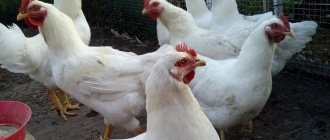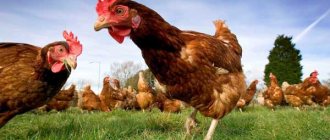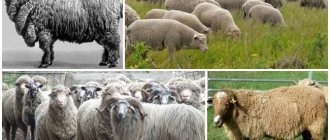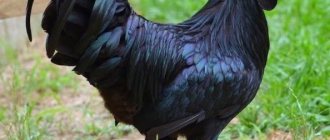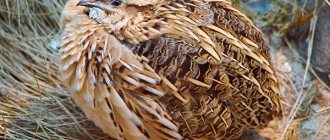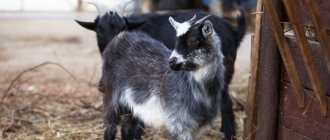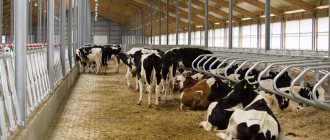The Czech goat is a beautiful animal with a calm, balanced character and high milk yield.
The breed is known by the following names: brown shorthair goat, Czech brown goat or Czech shorthair goat.
The unpretentiousness and small size of goats make them attractive for breeding in the home garden.
The main advantage is hypoallergenic milk with excellent nutritional properties.
In order to improve the general characteristics of the species, breeders have been developing new breeds over the years. Czech scientists did not stand aside.
Origin story
This breed was created in the first half of the 20th century.
This is the result of the crossing process:
- Native white and beige goats.
- German breeding brown goats;
- Pedigree alpine brown goats;
The breed was officially recognized in 1954 and finally approved in 1970. Until 1993, the breed standard required goats to be hermaphrodites, meaning hornless.
However, the hermaphroditism gene was actively transmitted through the line of mares. As a result, the number of hermaphroditic goats, possessing both male and female characteristics, has sharply increased among the Czechs.
In the early 1990s, the percentage of hermaphrodites among Czech goats was about 15 percent, and the breed was considered extinct. To save the breed, the standard was changed and the requirement for colostrum was removed.
As a result, the hermaphrodite population in the breed has dropped to 1.9 percent. Today, 80% of goats are bucks and the remaining 20% are horned.
Today there are about 400,000 Czech goats in the world. Half of them are bred on private farms, and the other half on commercial farms.
Thanks to the unpretentiousness and efficiency of these animals, the popularity of the breed is growing every year.
The history of the appearance of Czech goats
The official name of the animals is brown shorthaired, and they were bred in the second half of the last century. The “parents” of these individuals are Alpine and German brown goats. The selection process resulted in these wonderful animals with excellent productivity.
Czech goat
However, after a couple of decades, the population practically began to decline, and even for some time these goats were considered extinct. But inexplicably they reappeared and began to spread across different countries of the European continent. And at the moment, the number of Czech goats is increasing more and more.
Description of the breed
The goat is short-haired, with a thick undercoat and a strong build.
Color varies from milk chocolate to dark brown, depending on breeding region and genetics.
There is a dark stripe running along the back line so that there is no doubt.
Czech goats have small, flapping ears, a triangular and elongated snout, and a short tail. Only men have black beards.
A feature that distinguishes the Bohemian breed from other breeds is the dark triangles behind the ears. Most individuals are males (without horns). In appearance they resemble a dog, their behavior is just as intelligent, smart and friendly.
Goats with horns are occasionally found, but they make up less than 20% of all goats. If we continue to compare goats with dogs, they remember their names, respond to their pronunciation and can follow simple commands.
The weight of an adult male can reach 75-80 kg, females - up to 55 kg. Males reach a height at the withers of 85 cm and a chest girth of 90-110 cm. The height of a fully grown goat does not exceed 75 cm, and the volume of the chest reaches 100 cm.
Externally, the male is easy to distinguish from the female: he is larger and has a more muscular body. A fully filled goat's udder resembles a soft sac that folds into a fold when emptied.
Where to buy purebred Czech goats - nurseries
Until 2000, it was quite difficult to buy a Czech goat in our country, since the breed was not going through the best of times at that time. However, today everything has changed dramatically and there are many large nurseries, as well as private breeders who offer purebred animals at a very reasonable cost.
- In the Zadneprovsky district of the city of Smolensk, private breeder Victoria Ivanova offers milking goats and kids of the Czech breed with documentation.
- In the city of Korolev, Moscow region, the private farm “Olgin Dvor” offers kids and adult animals of the Czech breed of goats at a reasonable price. There are also mixed goats of the Czech and Alpine breeds from mothers with high milk yields. All necessary documents and certificates are available.
- Not far from the metro station “Biblioteka im. Lenin" in Moscow, manager Yulia Belova offers intermediary services for the purchase of Czech, Saanen and other dairy and meat-and-milk goats from a private farm in the Orekhovo-Zuevsky district.
- In the village of Diveevo, Nizhny Novgorod region, breeder Smirnovskaya O.N. offers young animals, as well as milk goats and breeding goats for breeding with all documents.
The cost can vary significantly depending on the age, purity of the breed and distinctive features, as well as the personal productivity indicators of each individual. You will have to raise a breeding breeder yourself or purchase an adult at a price of up to 100 thousand rubles. A purebred female will cost much less, only 30-45 thousand. Kids can be purchased at a price of 10-15 thousand rubles, which is quite acceptable.
Reviews about Czech goats
Anastasia Ozerova, 56 years old, Ivanovo:
“I always kept purebred Saanen goats, but one day I hesitated in finding a breeding goat for mating and improving the blood. Then it was decided to buy a Czech goat, as well as a couple of females. In addition to purebred Czech animals, today I also have good mixed breeds, tall, strong, who produce 6-8 liters of thick and tasty milk without any smell. I’m happy with everything, the Czechs don’t go overboard with grub and behave like the leaders in the herd when grazing, gathering all the animals into a heap and not allowing them to scatter.”
Valery Kapashin, 48 years old, Zelenograd:
“Czech goats, among all dairy goats, are my favorite and not by chance. They are calm, peaceful, loyal and behave like dogs. They immediately remember names, everyone knows their place, they love to come and lay their heads on their knees, looking into their eyes. They produce tasty milk, on average, 4-5 liters a day with three milkings. They go home from the pasture on their own; there is no need to tie them up either.”
Reviews
Czech hornless goat
According to farmers, the benefits are as follows:
- affordable price.
- high level of milk production;
- lack of constant male scent (noticeable only during mating)
- long lactation period;
- long lactation period; strong resistance with good care and feeding;
- unpretentiousness in food;
- rapid growth (7 months weighing up to 25 kg)
- high birth rate;
The Czech goat breed has disadvantages, but they are in the minority:
- decrease in milk yield in summer.
- risk of attack by blood-sucking insects due to short hair;
- heat intolerance;
- poor resistance to low temperatures;
What to look for when buying a purebred goat
In order not to make a mistake and not buy a mestizo of similar color, whose productivity will be several times less, and the offspring may be defective, you should take into account several factors.
- The main feature of Czechs is the color of their coat. It must be correct, with black legs and a stripe along the back, as well as triangles behind the ears and a darker muzzle.
- Goats in forty percent of cases have small sickle-shaped horns curved back. If you have a choice, it is better to buy a horned animal rather than a polled one, as there is a risk of getting offspring with hermaphroditism from it.
- When choosing adult females, be sure to pay attention to the size and shape of the udder. It should be large, regular and symmetrical, with elongated nipples.
- The legs of Czech goats are quite long, slender and strong, on small, neat black hooves.
It is optimal to apply for Czech goats to breeding nurseries, where they can provide you with all the documents for the animals. If the breeder is reluctant to make contact, does not know or does not want to disclose any information, this is a reason to think twice and cancel the purchase. You can come several times at different times, look at the livestock while grazing, at rest on vacation, and even taste and smell the milk. The absence of odor in goats can be determined by sniffing between their horns. If a characteristic aroma is not felt, then the breed is most likely pure.
Frequent diseases in the Czech breed
The main advantage of goats is their enviable resistance to various diseases. They rarely catch common goat infections, are not afraid of food contaminated with Brucella, and extremely rarely get pseudotuberculosis. Respiratory diseases are also infrequent guests in the herd of Czech goats; they are not afraid of low temperatures and colds.
- The main problem may be blood-sucking insects that spread the infection. The skin is dark in color, which is why bloodsuckers attack them first.
- If the floor is excessively damp and dirty, for example when kept on deep bedding, goats may experience hoof necrosis. Then the animal may begin to limp, and then completely refuse to get up. If you do not notice and start this process in time, you can lose the individual.
- Poisoning with botulism toxins also threatens Czech goats, so you should initially check what kind of silage you buy, since the reason often lies there.
To prevent such problems from arising on the farm, regular examinations and vaccinations should be carried out by a veterinarian.
Disadvantages of the breed
When choosing, you should also take into account the disadvantages, which are much smaller.
- These goats are not afraid of frost and cold, but they are not resistant enough to dampness and drafts.
- The productivity of Czechs throughout the year in different conditions can vary noticeably.
- They can't stand the heat and may even get stressed and faint in the sun, so be prepared for this. It is better to choose a pasture for such goats where there are a lot of bushes and trees that provide shade.
In the summer, water for goats should always be freely available, absolutely fresh and cool (not cold). When kept in open pens, there must be a canopy and platforms on which animals can jump and run, as well as simply lie down and relax in the shade.
Productivity
Meat
Czech goats have lean meat, which is widely used in dietetics. The slaughter of a 6-month-old kid yields 20 kg of fresh meat, and a one-year-old kid produces up to 45 kg. These indicators increase as the animal ages.
Czech goat meat tastes similar to veal, but its color is slightly darker. The layer of white fat is insignificant. The meat is tender and soft, but fibrous.
In order to increase meat yield, the goat is well fattened before slaughter. Goat meat has a specific smell that many people do not like.
To get rid of it, males are castrated. Before cooking, the meat is soaked in spices and marinade for several hours.
Dairy
The lactation period in females lasts 280-300 days a year. Such milk productivity increases the popularity and demand of Czech goats in agriculture.
1,000 kg of milk with a fat content of 3.5% can be produced per year. With good care, it can reach 2,000 kg.
Milk contains 3% protein, 5% lactose. The daily milk yield of an adult goat is from 4 to 6 liters.
Czech goat milk has a rich, creamy taste and pleasant aroma. You can use it to make cream, cheese, butter and feta cheese.
It is well absorbed by the body, does not cause allergies and does not disturb digestion. This hypoallergenic product is included in baby food and is beneficial for the child’s immune system.
Litter
This organic fertilizer is rich in nitrogen and is widely used in agriculture. Over the course of a year, a Czech goat produces 500 kg of manure (free-range), 1000 kg (in a barn).
To be suitable for agricultural use, manure must sit in compost bins for 6 months. Organic waste is also added there. Ready-made manure is applied in the spring before plowing.
Hide and skin
Soft, durable, flexible goatskins are used to make rugs, rugs and blankets with good insulating properties. They are placed on the floor, hung on walls, thrown on sofas and armchairs. This leather fits perfectly into eco-interiors made from natural materials.
Czech goatskins are used to cover lamps. Floor lamps, lampshades, chandeliers and sconces covered with this leather provide soft, subdued light and create a romantic atmosphere.
Goatskin outerwear has long become a classic. It looks presentable, does not get wet in the rain and is not afraid of getting dirty.
Designers and fashion creators use Czech goatskin for coats, jackets, vests, sheepskin coats, sleeveless vests and other items of clothing.
Czech goat skins are also used to make shoes, hats, gloves, bags, wallets and accessories. The finished products are practical and resistant to abrasion and contamination.
Czech goatskin is well suited for the production of musical instruments: tambourines, drums and maracas.
Leather is also used to make talismans, amulets, magical seals and all kinds of souvenirs.
Breeding
Young kids reach sexual maturity at 4-6 months of age, kids at 15-18 months, but should be raised in their second year when they weigh 40-45 kg.
Young goats can have their first offspring at 7-8 months, but their babies will be 30% smaller and lighter than their brothers born to adult sows.
Czech goats mate once a year. Hunting is seasonal and usually takes place between August and December. Pregnancy lasts from 21 to 23 weeks.
During pregnancy, the female's diet includes grains, vitamins and minerals, and a bowl of vegetables (2.5 kg) is given once a week.
Instead of whole wheat, they receive sunflower cake (100-150 g per day), whole oats, granulated feed and fresh pine branches.
Lambs are usually born in early spring. A few hours after birth, the young are already energetically running around their mother.
Until the age of one month, young animals receive milk four times a day. The break between feedings should not exceed 4-5 hours. From 1.5-2 weeks of age, goat kids are fed hay with a small amount of salt (4-6 g per day).
Goats also eat broom well. Later, succulent feed, chalk, bone meal, mixed feed, chopped root vegetables and boiled oatmeal are added to the calves’ diet.
With the onset of warm days, goats and young animals are released to pasture. The kids are separated from their mother and gradually taught to live without her milk. During this period, goats are fed feed with bone meal and salt.
At the age of eight months, a goat should eat 1.5 g of hay, 0.2 kg of feed and 1 kg of succulent feed daily.
Mating: how to organize it correctly
Breeding brown purebred goats is quite a profitable business because they are prolific and the livestock usually grows quickly. Females are capable of giving birth twice a year, but this should not be allowed, since the offspring may be weak and sickly, with signs of degeneration of the breed or hermaphroditism.
Remember
For mating, it is imperative to choose individuals that do not belong to the same litter, because closely related relationships can lead to mutations. When covering simple females, the first generation of offspring may have slightly higher productivity indicators, but already from the second generation the effect decreases to the initial characteristics.
Features and types of insemination of the Czech breed
Czech goats reach sexual maturity at approximately four to six months, but it is best not to breed them at that time. Experienced breeders recommend waiting until they are one year old and fully grown. Their hunt occurs approximately every 21 days (+/-3), it can be determined by restless behavior, frequent bleating, refusal to eat, or, conversely, increased activity, outbursts of mild aggressiveness. The breed is characterized by seasonal rutting, but in a warm barn with high-quality food and cleanliness, hunting occurs all year round once a month.
- Artificial insemination is the most progressive, with it it is easy to avoid unwanted accidental pregnancy. However, this requires that bucks and goats be kept in separate pens.
- Hand mating involves the selection of individuals for mating by the owner and placement in one stall for insemination.
- It is customary to practice free mating very rarely in modern goat breeding. Then in the herd there will be kids of different ages, and when keeping animals of different breeds together, this is completely unacceptable.
It is optimal to plan mating so that the kids are born in the spring; they are considered the strongest and hardiest.
Gestation period and lambing characteristics
The average duration of pregnancy in Czech women is 152 days, but very rarely everything coincides from day to day. More often you should expect deviations of 4-8 days in one direction or the other. You should prepare for the lambing process in advance: heat several buckets of warm water, prepare rags, scissors, a towel, etc. For the entire pregnancy, it is better to provide the goat with an enhanced diet, but not excessively, with grain concentrates and combined feeds. One and a half to two months before giving birth, the goat just needs to be “started”, that is, stop milking.
Ideally, kids should be immediately taken away from the uterus, and the first feeding of colostrum should be done from a bottle to start the immune system. But it should be taken into account that you will have to tinker for a whole month, feeding newborn animals with mother’s milk, after which it will only be possible to produce supplements in the form of fruits, vegetables, cereals and swill. When kept under the uterus, goat kids may not drink all the milk; it will burn out, which will negatively affect milk production in the future. To avoid this, you will have to milk the goats in the afternoon and in the evening.
Content
Bohemian goats are hardy and fertile if fed and maintained properly.
There are several specific methods of care:
- Feeding. Since animals are not picky eaters, feed them hay in winter and green grass in summer. To increase milk production in winter, enrich the Czech goat's daily diet with compound feed, leftover feed and fresh vegetables. In summer, graze your animals regularly, as green grass provides them with the maximum amount of vitamins and valuable microelements for strong immunity.
- Living conditions. Make sure each animal has its own raised bed or heated floor in the barn. Keep males and females separate, otherwise the offspring will be unplanned. Clean the room regularly as there is a risk of germ growth.
Goat house equipment
In order for the animals to guarantee good milk yield, and for the farmer to make a profit from them, it is important to equip the barn in accordance with the farmer’s rules.
The following preconditions must be met:
- Divide the facility into separate pens to isolate males and females.
- Windows facing south, at a height of 1.5 meters from the floor.
- Increase lighting, for example, 120-150 watt lamps per 20 square meters.
- Provide refreshments. The goat should always have access to clean water. Secure the drinking bowl in one position so that the animal cannot turn it.
- Make concrete floors to make dropping droppings easier. Cover them with straw to keep them warm.
- Prepare a bright and spacious room for the goats (4 square meters per animal).
- Build a wooden shed, cover it with straw and insulate the outside with mineral wool.
- Install a ventilation system in the barn to circulate fresh air throughout the barn.
- Avoid dampness and drafts, otherwise the animals will get sick and milk production will decrease.
- Make sure the yard faces south and is well cleaned after each grazing.
- Build a wooden platform as goats like to rest in their pens on higher ground.
Bohemian goats are heat-loving animals, but they do not tolerate excessive heat or humidity and suffer from drafts and low ambient temperatures.
The permissible humidity in the barn is no more than 75%.
The optimal temperature is 15-16 degrees Celsius in summer and at least 5 degrees Celsius in winter. If there is no space to set up a pen, the goat can graze on the front lawn.
To do this, take a metal peg and a rope (chain) 3-5 m long. When the animal eats all the grass in one place, move it to another.
Also drive a stake into the ground and leave the Czech to graze.
What do the owners say?
As a rule, reviews from Czech goat breeders contain the following arguments in favor of purchasing these animals:
- goats are clean and very unpretentious in food;
- thanks to their downy undercoat, they tolerate low temperatures well;
- heat is also not a problem for goats: during the summer shedding, their fur thins so much that it allows them not to overheat;
- lactation is constant and does not depend on the time of year: on average, one goat produces about 4 liters of milk per day.
Thus, if you decide to buy a goat, you won’t find a better option than the Czech Brown! Its flexible nature and unpretentiousness will make its maintenance very comfortable for the owner. And the milk of this goat will please the most demanding gourmets!
Feeding
Rough feed includes hay, straw, thin branches, young shoots and dry leaves. The Czech goat requires 1 to 3 kg of these ingredients in its daily diet.
Concentrated feed contains barley, oats, bran and corn. Adult goats are fed up to 1 kg of these supplements daily, while young goats need 500 g.
In order not to disturb the goats’ digestion, the grain should be crushed before feeding, the concentrate should be diluted with water, and the dough should be crushed. When feeding goats, do not spill grain on the floor.
Special feeders must be installed in the barn, otherwise dangerous microorganisms will get there along with the feed. The same applies to feeding goats outside.
Do not scatter grain on the ground; use a portable feeder made of wood, hard plastic or metal. Wash them after every feeding.
Adults
Feeding the animal depends on the season, gender and the farmer's ultimate goals for raising goats.
The daily diet should include the following types of feed:
- Succulent. More suitable for lactation period, supports milk production. These are vegetables with high moisture content. Feed gray bush stems in moderation, as well as boiled potatoes and fodder beets.
- Greenery. More suitable for the summer period, it is economically beneficial for goat farmers. Choose pastures with ryegrass, fescue, and timothy. Legumes such as peas, alfalfa, and lupine should also be included in a goat's daily diet.
- Dietary, mineral feeds. Feed goats supplements and mineral mixtures throughout the year. Legumes and grains, wheat bran, beet pulp and mineral mixtures are especially useful.
- Dry. More suitable for winter diet. This is hay made from field grasses and legumes, which the goat should eat from 1 to 2.5 kg per day. Give a fresh portion each time, as stale food smells unpleasant and loses its appetizing appearance. Dry food also includes barley straw and oats.
Little ones
After birth, young goats stand on their feet at the age of 2 days. By the age of 12 weeks, the litter is fed milk 4 times a day. As they grow older (up to 4-5 months), hay is introduced into the daily menu.
Having 4-6 grams of salt per day is mandatory. At the age of 7-8 months, goat kids can be fed food, boiled oatmeal, chalk and chopped vegetables.
An 8-month-old kid should eat 1 kg of soup, 1.5 kg of hay and 200 g of feed daily. From early childhood, goat kids graze together with adult animals, for the first time when it is warm.
When choosing a diet for your goat, pay attention to the presence of dangerous ingredients:
- Harmful plants. These include representatives of the rhododendron family. These are edible plants, but goats vomit and have diarrhea after ingesting them. If the animal is not treated quickly, it may die. Therefore, make sure that there are no such plants in areas where goats graze.
- Moldy hay. Dry food spoils if it is not properly stored and stored for the winter. Goats suffer from colic, the digestive system is disrupted and urgent veterinary attention is required.
Basic rules for drinking
Czech goats are fed 3-4 times a day at regular intervals. Be responsible not only for feeding, but also for drinking. The quality and quantity of milk production, as well as the health of boars, depend on these parameters.
Valuable advice from experienced goat breeders:
- Green algae on the walls of the drinking bowl must be thoroughly cleaned.
- In winter, goats drink in the morning and evening, the amount of water is not limited (as long as the animal drinks). Each goat requires an average of 5 to 8 liters of fluid per day.
- In winter, water for goats is slightly salted; in summer, special salt is placed next to the drinking bowl. In summer, special salt is placed next to the drinking bowl. With its deficiency, animals become lethargic, eat poorly and are poorly milked.
- The water should be maintained at an optimal temperature of 6 to 10 degrees Celsius.
- The number of drinking bowls should correspond to the number of animals in the barn.
- In hot weather, there should always be clean water in the drinking troughs in the barn. Goats drink it in unlimited quantities.
- After drinking, any remaining liquid should be poured away from drinkers. The water should be changed 2-3 times a day.
Care
Wool
The Czech goat is a short-haired breed that also requires careful grooming. Animals should be brushed every day. Use special rubber brushes to remove dirt, dust and excess hair, just like when grooming horses.
Keep the water warm while washing. Take care of your animal's fur with special medications for the treatment and prevention of parasites (a wide selection can be found in veterinary pharmacies).
If your Bohemian goat has fleas, treat your barn with copper sulfate. Use antiparasitic products daily until the bloodsuckers are gone.
Hooves
Remove dirt from the soles of animals after each grazing, otherwise sensitive skin may become inflamed. Hooves should be trimmed twice a year.
Do the same with the hooves:
- Do the same with the remaining hooves.
- Clean off any accumulated dirt.
- Trim the hooves from toe to heel.
- Make sure the cut is straight.
- Soak the hooves in a copper sulfate solution.
Advantages and disadvantages
Brown shorthaired goats are a common variety. You can meet them in many countries of the world. This popularity is explained by the following advantageous qualities:
- high milk productivity (daily milk yield reaches 6 liters);
- prolonged lactation (up to 10.5-11 months per year);
- nutritional value of milk, no specific goat smell;
- during the mating period, a barely perceptible odor emanates from the goats;
- fertility of females (in each litter female goats give birth to 2 kids, less often one or three);
- strong immunity, which makes maintenance less troublesome;
- low incidence rate if the vaccination schedule is followed and a balanced diet is provided;
- the absence of horns in some goats makes it easier to care for (polled animals have a balanced character);
- good interaction between animals and humans, ability to train;
- profitable breeding for commercial purposes.
If you want to acquire representatives of this breed, it is recommended to take into account the disadvantages of Czech goats:
- short hair poorly protects animals from blood-sucking insects, which complicates grazing;
- sensitivity to summer heat, dry air;
- in the heat there is a decrease in the qualities characteristic of the breed (decrease in milk yield, weakening of weight gain).
Diseases and their treatment
Goats rarely get sick, but problems with care and feeding may require urgent veterinary attention.
The most common diseases are listed below:
- Mastitis. Caused by poor milking technique, udder injuries, and poor animal care. Symptoms include pus and flakes in the milk, and hardening of the mammary glands. Without antibiotics, the goat's condition worsens.
- Gastroenteritis. Caused by a sharp change in the diet of young animals. Symptoms include constipation followed by diarrhea, lack of appetite, fever, and breathing problems. In addition to correcting the goat's diet, antibiotics are prescribed.
- Pneumonia. The reason is stress, overheating or hypothermia, errors in the daily diet. Symptoms include high fever, wheezing in the lungs, abnormal pulse, and lack of appetite. Treatment consists of antibiotic injections.
- Avitaminosis. Caused by a lack of vitamins A, B, C, E. Symptoms include growth retardation, impaired coordination of movements, and lack of appetite. Pharmacological treatment is not required if the goat's daily diet is balanced.
- Acute tympany. Caused by feeding the goat large amounts of fermentable foods. Symptoms include bloating, lack of chewing and loss of appetite. If treatment is not started on time, the goat may die.
To avoid disease in Czech goats, take effective preventive measures in the early stages:
- At the first symptoms of the disease, do not treat it yourself; immediately call a veterinarian at home.
- When choosing feeds and mineral supplements, consider the age of the goats and their specific life stage.
- Immediately vaccinate young animals and have them examined by a veterinarian for tuberculosis, brucellosis and other diseases.
- Clean and trim your hooves regularly to avoid dangerous infections.
- Keep barns dry and clean and ensure that pet goats receive proper nutrition.
Can it be crossed with other breeds?
Shorthaired Bohemians can be crossed with pure breeds of other goats. The resulting offspring usually inherit the characteristics of the Czech breed.
With successful crossing, the offspring are strong and healthy, and the crossed females produce more milk than their parents.
Several successful experiments have been carried out by crossing male Czech Shorthair goats with Saanen goats.
The resulting offspring had excellent milk yields and were well adapted to life in regions with harsh climates. The fur was thick and short, beige in color.
When they reached maturity, the young females began giving birth to at least three babies at a time, their milk had an excellent taste, was thick and had a consistency similar to cream.
It should be noted that such a good result was achieved only because Czech goats were crossed with purebred Saanen goats.
Productive properties
Brown goats are a highly productive and prolific breed. The annual milk yield of an adult female averages eight hundred liters of milk. Moreover, lactation lasts at least ten months. Some individuals give milk for three hundred days. During such a period, you can get two thousand liters of quality product.
For one lambing, a goat brings two or even three kids. The young animals develop quickly and during the first lactation they are already capable of producing up to two liters of milk. From the age of one month, goats begin to feed on their own and gain fifteen kilograms of weight by two months.
The milk of brown goats has an excellent taste. It contains three and a half percent fat and about three percent protein. The product has a thick consistency and a slight creamy taste. The meat of young animals is tender, similar in taste to veal.
Thanks to its effective indicators, the gene pool of the Czech goat breed is effectively used in European breeding programs.
Prospects for breeding in Russia
Czech goats are very popular in Russia due to their omnivorous nature, high milk production, good immunity and health.
Even the rather high price of animals does not deter those who want to purchase this breed. Despite the fact that this breed is famous for its merits, it has not yet become widespread in central Russia.
The fur of these goats needs to be brushed regularly. It should be taken into account that in cold Russian winters the coat grows quickly, so regular grooming is necessary.
In the Russian Federation it is not easy to purchase such goats in the required quantity. When an owner finds a few purebreds, he begins breeding them and waits for the herd to grow over the course of five to six years.
If there are no goats of the Czech breed in the herd, crossing with local goats occurs, which gradually leads to a loss of purity of the breed. Czech goats are mainly found in the Altai and Primorsky territories, Khakassia, Voronezh, Pskov and Sverdlovsk.
Suppliers in Russia
Representatives of the Czech breed are quite affordable to buy in Russia. Moreover, the import of animals from abroad is complicated by various documents certified by the veterinary service. Breeding individuals brought from the Czech Republic cost twice as much as their fellow tribesmen raised in the Russian Federation.
In Russia there are many breeding farms engaged in breeding graceful animals. Farmers from the Pskov region and Altai Territory won the greatest recognition. Other breeders include:
- “Koza-Dereza”, Krasnoyarsk;
- "Nadezhda", Tver region;
- Private household plot of the Smirnovs, Pskov region;
- Private household plot of the Yukhatskovs, Moscow region;
- Private household plot of the Slugins, Krasnoyarsk region;
- "Chekhov's Compound", Moscow region;
- “Northern Lights”, Murmansk region;
- "Forest Region", Nizhny Novgorod.
When choosing a particular livestock farm, you can obtain the necessary information about the maintenance of Czech goats, the nuances of feeding and care, and breeding the breed to increase the number of livestock.
